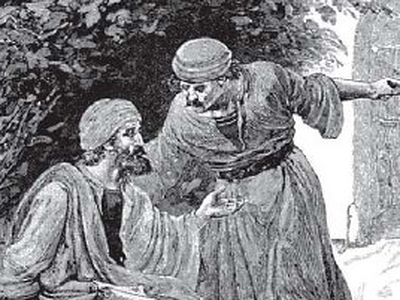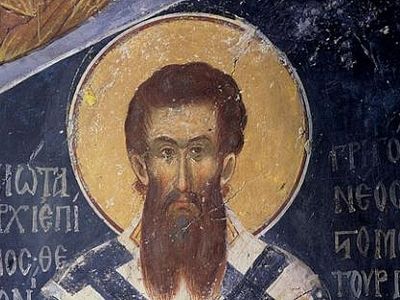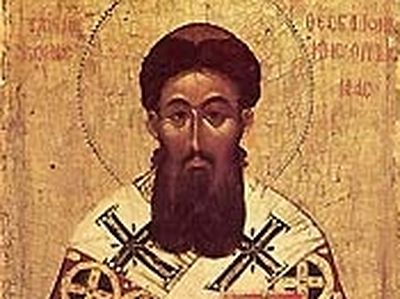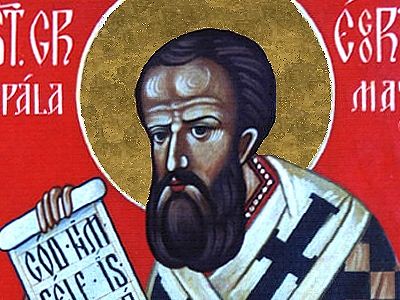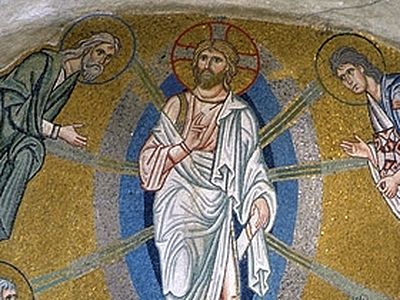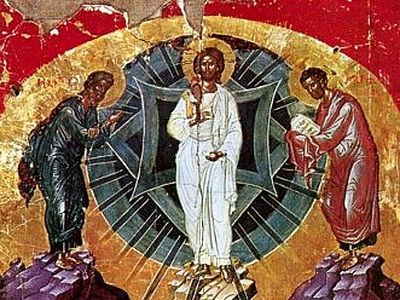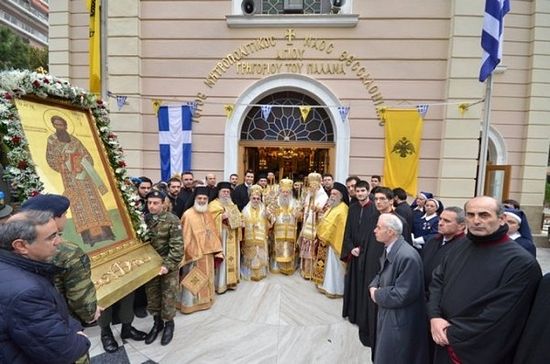
On the second Sunday of Great Lent, there is a great feast in the blessed city of Thessalonika, Greece. It is the feast of St. Gregory Palamas. On this day, the holy relics of the saint are taken from the Church of St. Gregory in a procession throughout the city, escorted by bishops, priests, sailors, policemen, and thousands of faithful. One wonders why his earthly remains are still held in such great veneration. How could his bones remain incorruptible more than six hundred years after his death? Indeed, St. Gregory’s life clearly explains these wondrous facts. It illustrates the inspired words of the apostles that our bodies are temples of the Holy Spirit (see 1 Corinthians 6:19) and that we are "partakers of the divine nature” (2 Peter 1:4).
A Childhood Passion for the Eternal
St. Gregory Palamas was born in the year 1296. He grew up in Constantinople (now Istanbul, Turkey) in a critical time of political and religious unrest. Constantinople was slowly recovering from the devastating invasion of the Crusades. It was a city under attack from all sides. From the west, it was infiltrated by Western philosophies of rationalism and scholasticism and by many attempts at Latinization. From the east, it was threatened by Muslim Turkish military invaders. The peace and faith of its citizens were at stake.
Gregory’s family was wealthy. His father was a member of the senate. Upon his father’s sudden death, Byzantine Emperor Andronikos II Paleologos (1282–1328), who was a close friend of the family, gave it his full financial support. He especially admired Gregory for his fine abilities and talents, hoping that the brilliant young man would one day become a fine assistant. However, instead of accepting a high office in the secular world, Gregory sought “that good part, which will not be taken away” from him (Luke 10:42).
Upon finishing his studies in Greek philosophy, rhetoric, poetry, and grammar, Gregory, at only twenty or twenty-two years of age, followed a burning passion in his heart. Like a lover who strives to stay alone forever with his loved one, Gregory was thirsty for this living water (see Revelation 22:17). Therefore, no created thing could separate him from the love of God (see Romans 8:39). He simply withdrew to Mount Athos, an already established community of monasticism. He first stayed at the Vatopedi Monastery, and then moved to the Great Lavra.
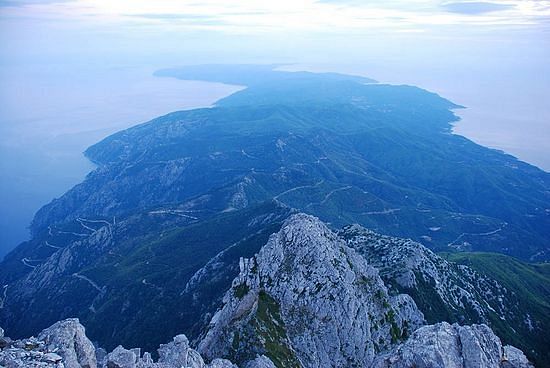 Mount Athos. Photo: AgionOros.ru
Mount Athos. Photo: AgionOros.ru
Gregory’s departure was not a surprise to the rest of his family. Many priests and monks, friends of the family, frequently visited the family home. The parents were careful to pass on to their children the “pearl of great price” (Matthew 13:46). Great wealth and high education were not a hindrance, but an excellent tool in their pursuit of salvation. As a result of their way of life and belief, Gregory’s mother, two brothers, and two sisters soon distributed all their earthly possessions to the poor and entered different monasteries.
Living the Spiritual Experience of the Church
In Athos, the novice Gregory took as his spiritual guide St. Nicodemos of Vatopedi Monastery. This holy man of prayer guided Gregory on the path of ascetic labor: prayers, vigils, fasting, continuous repentance, and monastic obedience. The young novice Gregory was especially attached to the prayer of the heart, also known as the Jesus Prayer: “Lord Jesus Christ, Son of God, have mercy on me, a sinner” (see Luke 18:38).
The experienced practice of the Jesus Prayer, requiring solitude and silence combined with physical exercises and breathing methods, is called "hesychasm" (from the Greek hesychos, meaning inner stillness, peace, or silence). Those practicing it are called "hesychasts." Inner silence of this kind makes us capable of listening to the whispers of the divine within us. "The kingdom of God is within you" (Luke 17:21). Therefore, the Jesus Prayer is the prayer of the whole person, involving the human body, mind, soul, and heart.
The hesychasts spoke and wrote about their unique experience. They taught people to pray without ceasing, as the Apostle Paul commands allChristians to do (1 Thessalonians 5:17). They explained that in prayer, man is filled from within with the eternal glory, with the divine light beheld at the Transfiguration of Christ on Mount Tabor. The hesychast Gregory explains:
For, on the day of the Transfiguration, that Body, source of the light of grace, was not yet united with our bodies; it illuminated from outside those who worthily approached it, and sent the illumination into the soul by the intermediary of the physical eyes; but now, since it is mingled with us and exists in us, it illuminates the soul from within. (Triads I. 3.38)
The Jesus Prayer is not a mantra, as in Eastern religions, and it cannot be taken as such. The prayer’s call for “mercy” involves inner repentance and change. It is also a prayer practiced within the sacramental life of the Church, a prayer combined with Holy Communion, confession, reading the Word of God, fasting, loving one’s neighbor, and so forth. Finally, it is not a prayer using “vain repetitions” or babble, but a prayer recited again and again, in persistence (Luke 18:1), from the inner heart of man reaching the divine heights of glory, confessing Christ as the Lord and Savior, in sincerity, humility, and faith.
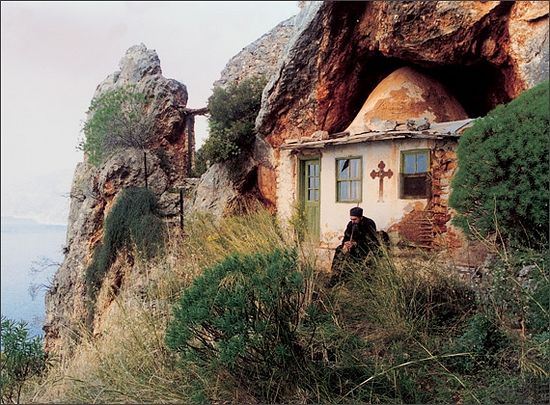
For that prayer (the Jesus Prayer) is true and perfect. It fills the soul with Divine grace and spiritual gifts. As chrism perfumes the jar the more strongly the tighter it is closed, so prayer, the more fast it is imprisoned in the heart, abounds the more in Divine grace. . . . By this prayer the dew of the Holy Spirit is brought down upon the heart, as Elijah brought down rain on Mount Carmel. This mental prayer reaches to the very throne of God and is preserved in golden vials. . . . This mental prayer is the light which illumines man's soul and inflames his heart with the fire of love of God. It is the chain linking God with man and man with God. (Palamas, “Homily on how all Christians in general must pray without ceasing,” in E. Kadloubovsky and G. E. H. Palmer, Early Fathers of the Philokalia, London: Faber and Faber, 1981, pp. 412–415)
Such prayer was practiced from the early Christian period. The hesychasts were drawn by God's unconditional graceful love (Romans 5:15) to fill a certain human need around them. Many hesychasts abandoned their solitude to serve their brothers, “since he who loves God must love his brother also” (1 John 4:21). Some cared for the sick in hospitals, like St. Basil the Great in Caesarea; others helped the poor, like St. John the Almsgiver in Alexandria; and yet others welcomed the faithful for confession. Nevertheless, they did not abandon the Jesus Prayer and their inner silence. In this sense, all Christians are called to follow this hesychast way leading to salvation.
Let no one think, my brother Christians, that it is the duty only of priests and monks to pray without ceasing, and not of laymen. No, no; it is the duty of all of us Christians to remain always in prayer . . . every Christian in general should strive to pray always, and to pray without ceasing . . . this very name of our Lord Jesus Christ, constantly invoked by you, will help you to overcome all difficulties, and in the course of time you will become used to this practice and will taste how sweet is the name of the Lord. . . . For when we sit down to work with our hands, when we walk, when we eat, when we drink we can always pray mentally and practice this mental prayer—the true prayer pleasing to God. (“Homily on how all Christians in general must pray without ceasing”)
In addition to his spiritual practice and daily scriptural readings, St. Gregory studied the works of the great Fathers, theologians, and ascetics of the Church. Just as a scientist builds on the evidence and data provided to him by his predecessors, Gregory made a fascinating synthesis of the scriptural and patristic teaching on the prayer of the heart, combined with his personal experience.
Although the monk Gregory in his youth had diligently studied Greek philosophy, he was not influenced by its views on matter. Ancient Greek philosophy believes that the body imprisons the soul, and thus it detests matter. Christians respect the body, since Christ made the flesh a source of sanctification, and matter (water, oil, etc.) a channel of divine grace. In his writings, St. Gregory affirmed that man, united in body and soul, is sanctified by Jesus Christ, who took a human body at the Incarnation. “When God is said to have made man according to His image,” wrote St. Gregory, “the word man means neither the soul by itself nor the body by itself, but the two together.” In another place, he added:
Thus the Word of God took up His dwelling in the Theotokos in an inexpressible manner and proceeded from her, bearing flesh. He appeared upon the earth and lived among men, deifying our nature and granting us, after the words of the divine Apostle, “things which angels desire to look into” (1 Peter 1:12). (A Homily on the Dormition of the Theotokos and Ever-Virgin Mary)
Father Gregory, Teacher
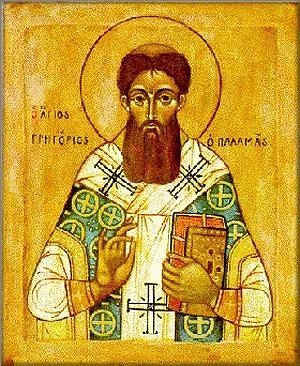 St. Gregory Palamas
St. Gregory Palamas
As a priest, Gregory did not abandon his spiritual labor and hesychasm. He spent most of the week alone in prayer. On the weekends, he celebrated divine services and preached sermons. He cared for the youth, calling them to discuss religious issues with him. Father Gregory was not concerned about abstract problems of philosophy, but about Christian faith experienced in prayer. He wanted to preach solely about problems of Christian existence, which are more attractive and meaningful to the young.
Soon, many of his spiritual sons expressed their desire to live in a monastic setting. So in the serene area of Vereia, near Thessalonika, he established a small community of monks, which he guided for five years. In 1331 the saint withdrew to Mt. Athos and lived in solitude at the Skete of St. Sabbas. In 1333 he was appointed abbot of the Esphigmenou Monastery in the northern part of the Holy Mountain. In 1336 he returned to the Skete of St. Sabbas, where he devoted himself to theological writing, continuing with this work until the end of his life.
But amidst all this, in the 1330s events took place in the life of the Eastern Church that placed St. Gregory among the most prominent teachers of Orthodox spirituality.
The Challenge of Rationalism
Around the year 1330, a certain monk Barlaam arrived in Constantinople from Calabria, Italy. He was a famous scholar, a skilled orator, and an acclaimed Christian teacher. Barlaam visited Mt. Athos and became acquainted with hesychasm.
Barlaam valued education and learning much more than contemplative prayer. Therefore, he believed the monks on Mount Athos were wasting their time in contemplative prayer when they should be studying. He ridiculed the ascetic labor and life of the monks, their methods of prayer, and their teachings about the uncreated light experienced by the hesychasts. Countering the traditional stance of the Church that “the theologian is the one who prays,” Barlaam asked: “How can an intimate communion of man with the Divine be achievable through prayer, since the Divine is transcendent and ‘dwelling in unapproachable light’ (1 Timothy 5:16)? No one can apprehend the essential being of God!” Barlaam was convinced that God can be reached only through philosophical, mental knowledge—in other words, through rationalism.
The words of Barlaam were not merely a challenge to a few monks. They defied the experience of the Church as a whole. The West, with its rationalistic tendencies, has associated the image of God with man’s intellect. Barlaam’s mind was full of rational arguments, but his heart was cold. Certainly, life with God is not just information, but also experience. Our living God cannot be conceived and described only by study, but must be spoken about from experience. “Did not our heart burn within us while He talked with us on the road, and while He opened the Scriptures to us?” (Luke 24:32).
Journeying from Mt. Athos to Thessalonika and Constantinople, Barlaam clashed with the monks, refusing to test their way of vigils, prayer, and fasting, or to accept their spiritual experience. Unfortunately, many monks were swayed by his arguments and stood by his side. Deceived by considering the living faith as mere rational knowledge, Barlaam waged a war against the ascetics.
At the request of the Athonite monks, St. Gregory countered at first with verbal admonitions. But seeing the futility of such efforts, he put his theological arguments in writing. Thus appeared the Triads in Defense of the Holy Hesychasts in the year 1338.
The Presence of God in Prayer
In his Triads, Palamas interpreted the experience of the Church by presenting logical arguments, based on the Scripture and the writings of the Fathers. Addressing the question of how it is possible for humans to have knowledge of a transcendent and unknowable God, he drew a distinction between knowing God in His essence, or nature, and knowing God in His energies, actions, or the means by which He acts.
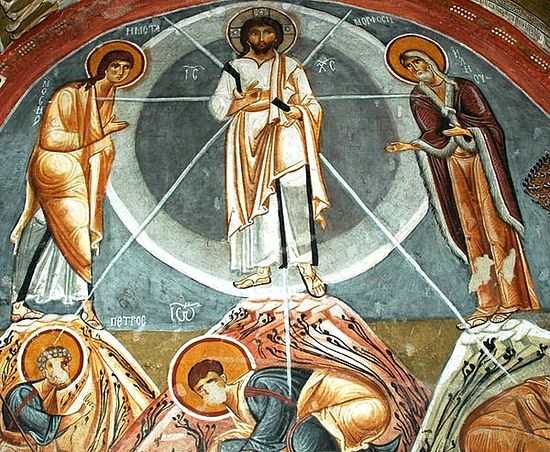
To elaborate more, he made a comparison between God and the sun. The sun has its rays, God has His energies (among them, grace and light). By His energies, God creates, sustains, and governs the universe. By His energies, He transforms creation and deifies it, that is, He fills the new creation with His energies as water fills a sponge. These actions or energies of God are the true revelation of God Himself to humanity. So God is incomprehensible and unknowable in His nature or essence, but knowable in His energies. It is through His actions out of His love to the whole creation that God enters into a direct and immediate relationship with mankind, a personal confrontation between creature and Creator.
Towards the year 1340 the Athonite ascetics, with St. Gregory’s assistance, compiled a general reply to the attacks of Barlaam, the so-called Hagiorite Tome. Since the heated arguments flared everywhere in the churches, a general council was held at Constantinople in the year 1341. In front of hundreds of bishops and monastics, St. Gregory Palamas held an open debate with Barlaam in the halls of the Great Church of Hagia Sophia. On May 27, 1341, the council accepted the position of St. Gregory Palamas that God, unapproachable in His essence, reveals Himself through His energies, which are directed towards the world and are able to be perceived, like the light of Tabor, but which are neither material nor created. The teachings of Barlaam were condemned as heresy, and he himself was anathematized and returned to Calabria.
Second Triumph of Orthodoxy
But the dispute between the Palamites and the Barlaamites was far from finished. Politics came into play, and the politicians used the disputed religious issue as a threatening tool against those who supported Palamas. The great turmoil led to five consecutive church councils. One of the many scholars who advocated Barlaam’s position was the Bulgarian monk Akyndinos, who wrote a series of tracts against St. Gregory. Emperor Andronikos III Paleologos (1328–1341) was Akyndinos’s friend. Fearing the emperor, Patriarch John XIV Kalekos (1341–1347) backed Akyndinos, calling St. Gregory the cause of all disorders and disturbances in the Church (1344). He had St. Gregory locked up in prison for four years. In 1347, John XIV was replaced on the patriarchal throne by Isidore (1347–1349), a friend of St. Gregory. He set St. Gregory free and ordained him archbishop of Thessalonika.
In 1351, a sixth and final council was held to settle the heated controversial issues in the church. The Council of Blachernae solemnly upheld the orthodoxy of Palamas’ teachings and anathematized and excommunicated those who refused them. The anathemas of the council of 1351 were included in the rite for the Sunday of Orthodoxy in the Triodion. This council was considered the second triumph of Orthodoxy (the first being the restoration of icons). Later on, the memory of St. Gregory Palamas came to be celebrated in the Church on the second Sunday of Great Lent.
Imprisoned by Muslims
Gregory’s suffering for Christ did not end here. Again, because of the political influence of the West in Thessalonika, its citizens were divided upon the issue proclaimed by the councils. They did not immediately accept St. Gregory as archbishop, so that he was compelled to live in various places. On one of his travels to Constantinople, the Byzantine ship on which he was sailing fell into the hands of the Turkish Muslims. They took Archbishop Gregory as a prisoner, but displayed tolerance toward him. Even in captivity, St. Gregory preached to Christian prisoners and even held many debates with his Moslem captors. His love and respect for all men made his captors admire him and treat him with reverence. A year later, St. Gregory was ransomed and returned to Thessalonika.
The Proclamation of His Sainthood
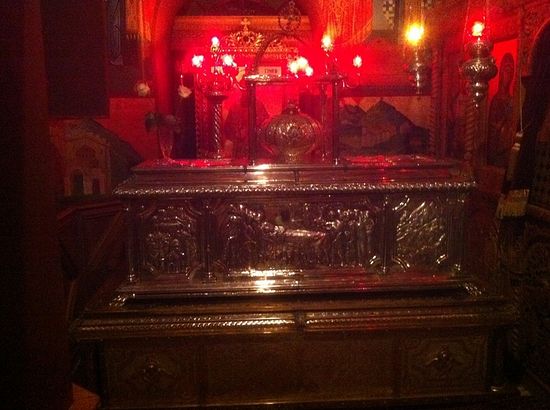 The reliquary of St. Gregory Palamas inside the Metropolitan Church, Thessaloniki
The reliquary of St. Gregory Palamas inside the Metropolitan Church, Thessaloniki
St. Gregory was a living Gospel. God gave him the gift of healing, especially in the last three years before his death. On the eve of his repose, St. John Chrysostom appeared to him in a vision. St. Gregory Palamas fell asleep in the Lord on November 14, 1359. The Virgin Mary, the Apostle John, St. Dimitrios, St. Antony the Great, St. John Chrysostom, and angels of God all appeared to him at different times. Nine years after his repose, a council in Constantinople headed by Patriarch Philotheos (1354–1355, 1362–1376) proclaimed the sainthood of Gregory Palamas. Patriarch Philotheos himself compiled the life and services for the saint.
When we hear in the Lenten Liturgy of the Presanctified Gifts, “The Light of Christ illumines all,” may we remember the call of the illumined Gregory for unceasing prayer and ascetic labor, that we be truly illumined by the light of the Resurrection.

